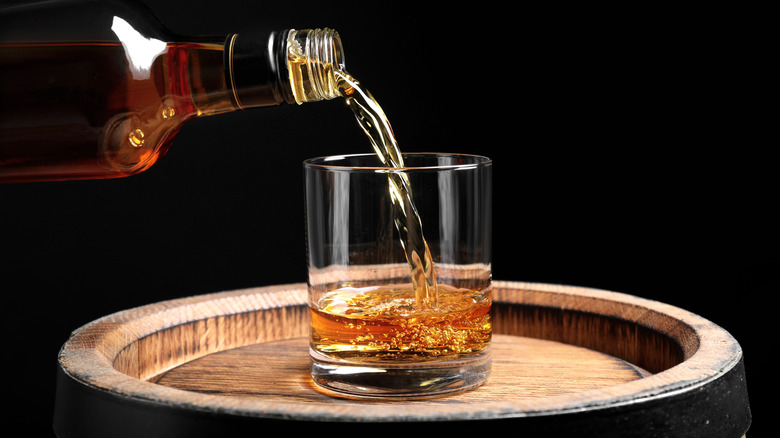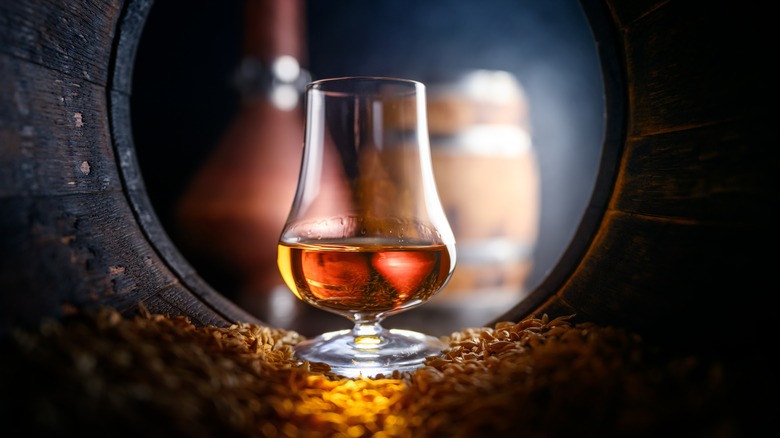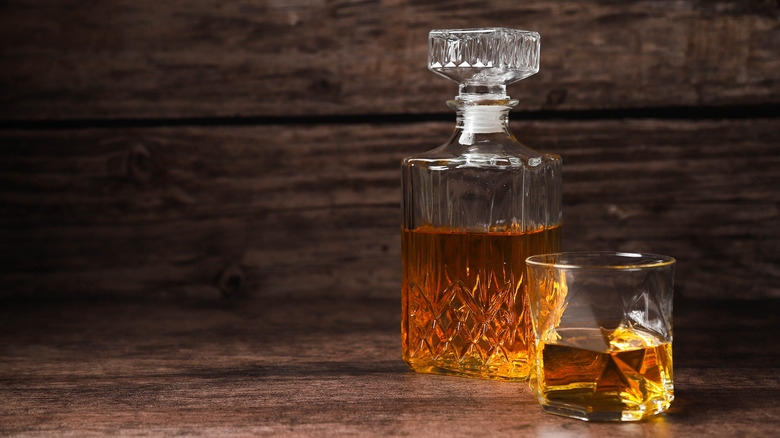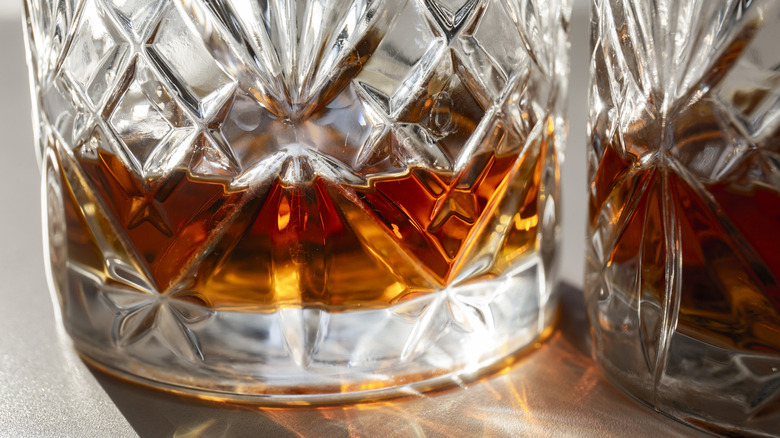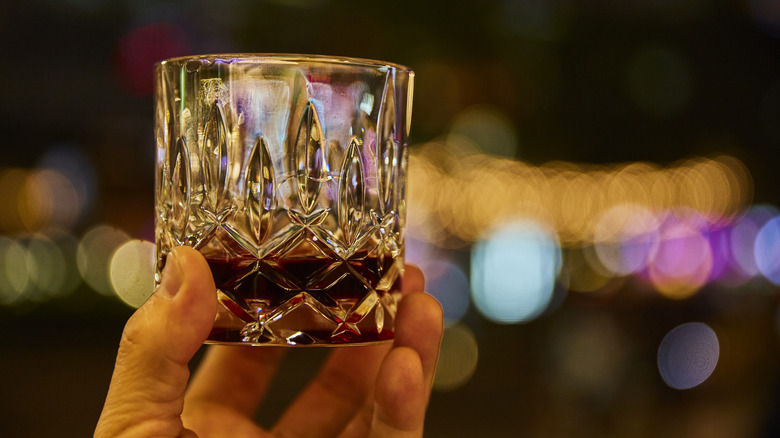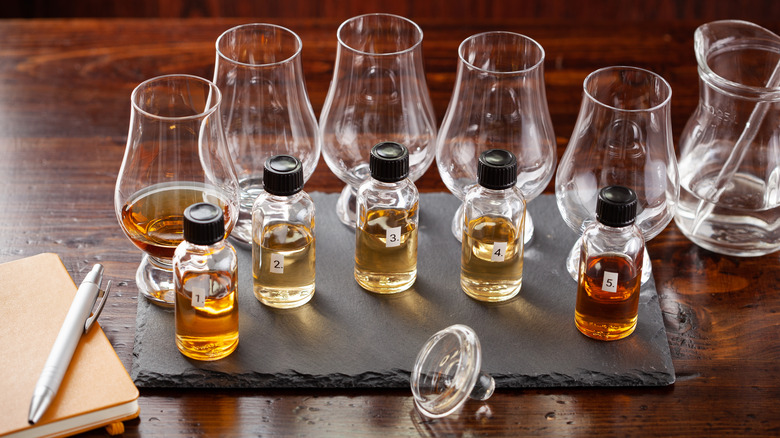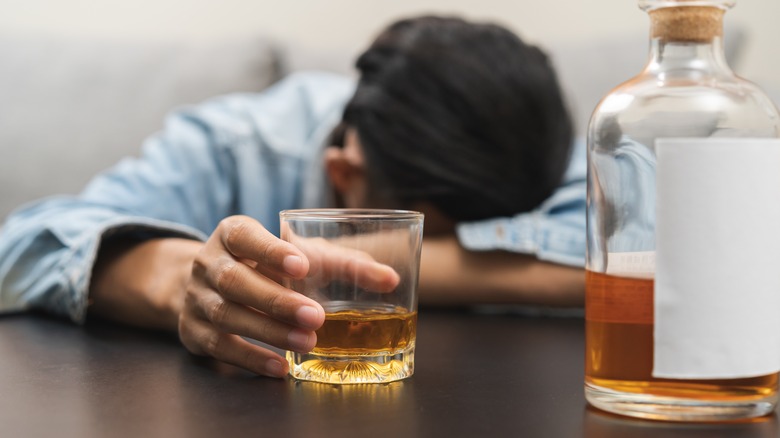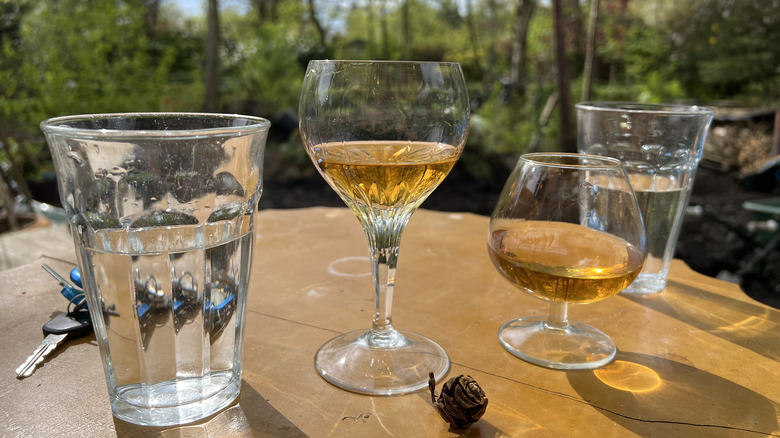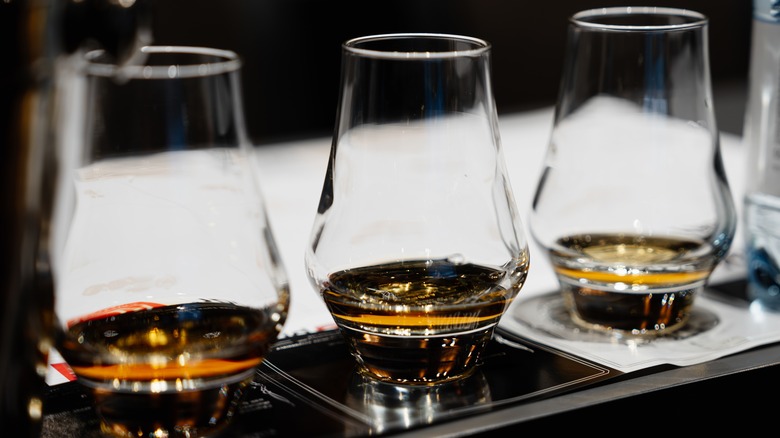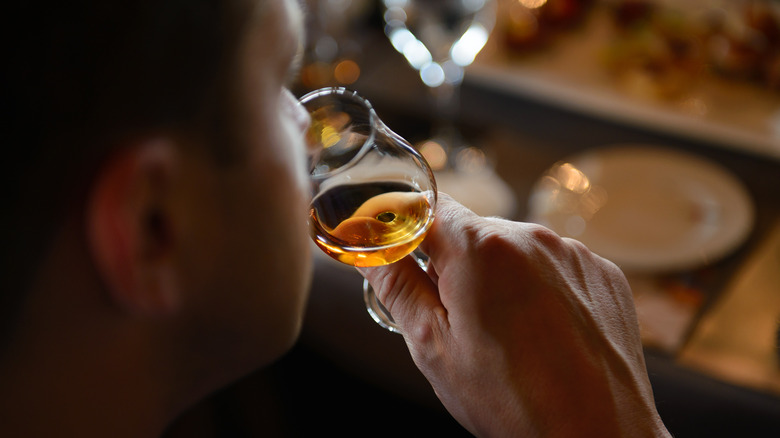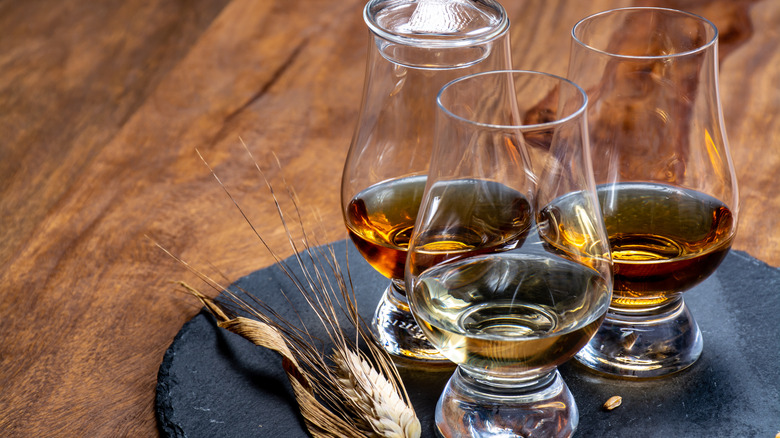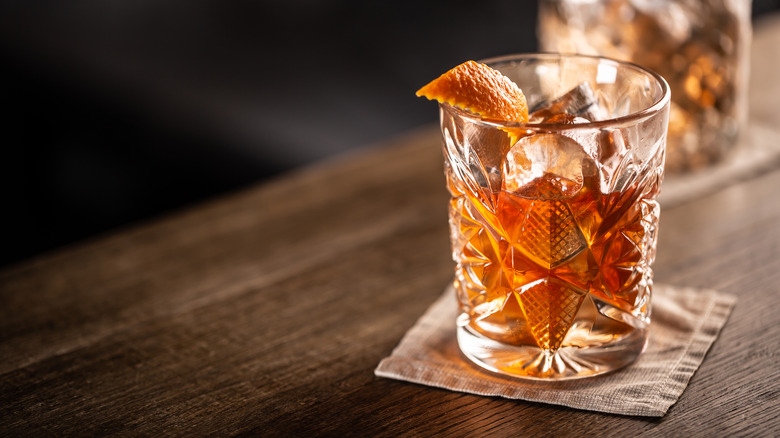12 Tips For Drinking High-Proof Bourbons
Drinking high-proof bourbon can be a joy for any enthusiast. These bottles are usually more robust, have greater depth than lower-proof bottles, and offer a different tasting experience. Due to this, it's important to know what to expect and how you can make the most out of your high-proof bourbon. There is no set definition of what qualifies as "high-proof." Some would say anything over 100 proof, but I'd put that a little higher at 110, with truly high-proof whiskeys being around the 120 mark. It may seem an obvious point, but the difference between drinking an 80-proof bottle and a 120-proof bottle is vast.
That's why I'm here to help. I've had many years of drinking high-proof spirits and I wish I had known all of these tips before I started. But my rookie errors from years gone by are now mistakes you can avoid making. Every whiskey expert once had to adjust to high-proof bourbon, and I was no different. If you follow these tips, you can start your own journey to enjoying strong bourbon and eventually become an expert yourself.
1. Start with small sips
TV shows such as "Mad Men" have romanticized drinking whiskey but also give the impression that it's easy to drink. In the show — along with many other examples — you see them gulping down big glasses without flinching. This is unrealistic, as doing so would cause most people to cough and splutter. This is true of low-proof bourbon but with higher-proof bottles, it's even more pertinent. I've drunk more bourbon than I'd care to admit, and even I can't gulp a glass down. But then again, why would I — or anyone else — want to? Not only is it difficult, it's a waste.
High-proof bourbon is meant to be savored. One of the best beginner tips for drinking bourbon is that small sips are always the best. This will stop the alcohol from overwhelming your mouth and give you a better chance to savor the tasting notes. If you've already gotten used to drinking low-strength bourbon, then take slightly smaller sips than you usually would. You can then build up to your normal amount when you've gotten used to the high heat. Taking big gulps of high-strength spirits isn't impressive and you'll just end up burning your throat, leaving you unable to properly taste anything until you recover. Give your high-strength bourbon plenty of respect.
2. Try high-quality bourbon
As we mentioned there, alcohol can burn. The spirit will irritate your mouth and trick your brain into thinking there is a drastic increase in temperature. If this sounds unpleasant, it's complicated. Lower-quality spirits usually have more impurities in the drink that can lead to a harsher taste. The higher the proof of the bourbon, the worse the alcohol burn will be, and the harsher taste is made even more noticeable. Buying a cheap high-proof bourbon will likely leave you disappointed as it can be hard to pick out any flavor at all and it can feel like you're drinking pure alcohol.
With high-quality bourbon, it feels different. Instead of a harsh burn, the drink will give you an intense warmth. If it feels like I'm saying the same thing two ways, you'll understand once you try quality high-proof bourbon. Without as many impurities, you get a much more pleasant experience and after a few sips, you'll even enjoy letting the alcohol sit in your mouth. I'm not asking you to spend big bucks here. Even spending an extra $10-$20 will make a big difference in the quality of the whiskey. It would be understandable if you've been put off by cheap, strong bourbon. It can be an assault on the senses. If you want to step up to those higher proofs, treat yourself to a well-respected bottle.
3. Expect to be disappointed
Here I have a word of warning as I don't want you to take a few sips and decide that high-proof bourbon isn't for you. For whiskey experts, it can be hard to remember when you first started with high-proof bourbon, but it can be overwhelming. Have you ever recommended a TV show to someone, but it has a slow start? You tell them they need to stick with it for a few episodes before they start to enjoy it. High-proof bourbon can be like that. When you first start drinking it, you may think that it's not for you and that you should stick to lower-proof offerings.
It can take a while for your mouth and brain to adjust to what it's being asked to process. For many, this can leave them disappointed with high-proof bourbon without ever giving it a proper try. Not only would I say you should try multiple glasses before making your decision, but you should give it a few tasting sessions over several days. For some people, they may take to high-proof bourbon straight away, for others, it can take time. Don't like it? No problem, some people don't. However, I'd still recommend trying it again in the future to see if your palate has changed.
4. Master low-proof bourbons first
Are you new to drinking bourbon? If so, I'd recommend sticking with the best low-proof bourbons for a while. For those new to spirits, even drinking 80-proof alcohol can take time to get used to. It still has a high alcohol content, and your body needs to get used to realizing the burning sensation is one of pleasure, not pain. As I mentioned in the introduction, there are no set rules on what constitutes low or high-proof bourbon. I view low-proof bourbons as anything below the 100-proof mark and this is where I'd draw the line for a new drinker.
Even the difference between 80- and 100-proof can be significant, and it's better to make smaller steps than jump from an 80- to a 120-proof bourbon, for example. A bourbon-lover could spend their whole life just enjoying low-proof bourbon as there is a vast array of options to choose from. If you're excited about bourbon, it's understandable that you'd want to sample everything it has to offer. But first, you should explore bottles from different states, with different mash bills and distillation processes. This will make you perfectly equipped when it's time to increase the alcohol content.
5. Hold off on your tasting notes
Writing down your tasting notes is one of the joys of drinking bourbon. You can create a record of each one you've tasted and use these notes to compare against your future bottles. With low-proof bourbons, you can quite quickly identify the most popular tasting notes. It can still take several sips, but it presents itself to you much quicker. High-proof bourbons are a little different. As they can dominate your senses, it can be difficult to pick out the more subtle flavors.
When you taste a whiskey, you'll often get hit with an initial flavor before secondary flavors appear as you let the bourbon sit on your tongue and roll around your mouth. It's these secondary flavors that can be hard to find when first tasting strong bourbon. You should take a little longer than usual when writing down your tasting notes until you're satisfied you've sampled the whole spectrum of notes. Even if you find even more subtle flavors after making your notes, go back and amend them. Eventually, you'll get a feel for tasting these higher-strength offerings as your experience increases.
6. Keep a check on your drinking
You're already drinking 90-proof bourbon, what's another 20 or 30 added on to that? The answer: Surprisingly a lot. It's an easy mistake to think that all whiskey is going to hit you the same, but that's far from the truth. You can have just a few glasses of high-proof bourbon and find yourself surprisingly drunk. It can hit you quickly which may be a little disorienting for some.
Subconsciously you may expect yourself to be a certain level of drunk after a few glasses, but there comes a point where it can hit you like a wave. Because of this, it's a good idea to drink water alongside your whiskey as this will soften the blow and allow you to better navigate your night of drinking strong spirits. You can also make other changes, such as switching back to a lower-strength bourbon when you've had a glass. Either way, just be mindful that you're drinking a significantly higher quantity of alcohol than you're accustomed to.
7. Try it with water
Alongside drinking water with your whiskey, you should also try water mixed in with it. It's a misconception — and a common bourbon-tasting mistake — that you shouldn't dilute whiskey with water. The wrong line of thinking is that it can mute the flavor and isn't how whiskey should be savored. While it's true that some flavors may be muted, adding water can open up plenty more nuanced flavors that you may not otherwise have found. It's due to this that I'll always recommend trying a high-strength bourbon, both neat and with water.
You can even experiment with just how much water you add, up to a ratio of 1:1. While it's not an absolute must, you want this water to be fairly pure. Some argue you should add pure distilled water, others that high-quality spring water is fine. I've always found spring water to be better as whiskey is almost always made with natural freshwater, anyway. Over time, you'll find your own perfect way of adding water. If anyone sneers at you for adding water to your whiskey, just smile politely and ignore them.
8. Try different types of high-proof bourbon
High-proof bourbon can come in all different varieties. The most common type you'll see is "barrel proof". This means the whiskey was bottled at the same proof it came out of the barrel. Most whiskey is "cut" with water before it is bottled — this is why so many bottles are sold at a round figure of 80 or 90 proof. The strength of barrel-proof bottles will change from one batch to the next, as the exact percentage can change slightly between barrels. If you see a whiskey labeled as "barrel proof" or "cask strength," it means the same thing.
There is also "full proof" which is slightly different — this is whiskey with the proof upon entering and exiting the barrel. Whiskey evaporates in the barrel, increasing its strength. Full proof adds a bit of water back to return it to its original proof. However, high-proof bourbon doesn't have to be barrel or full-proof. Small batch and single-barrel whiskeys can be cut with a little water and still have a proof above 100. A good idea is to sample these types of slightly lower-strength bottles first as a bridge to barrel-proof offerings. Whatever route you take, it's a great idea to try a few different bottles before you decide whether or not high-proof bourbon is for you.
9. Be cautious when nosing
I've already talked a lot here about the alcohol burn which can overwhelm your throat. However, the same can happen with your nostrils. Alcohol evaporates at room temperature and when you pour your bourbon, alcohol vapors will leave the glass immediately. If you stick your nose straight in there and take a big sniff, it can be akin to taking smelling salts. You'll immediately throw your head back and think that someone has just burned off all your nostril hair. It's not nice but is easily avoided. The first thing you want to do is let your whiskey sit for a minute or two and allow it to open up. The time recommended for this can vary, with the common recommendation being to let whiskey breathe one minute for every year it has been aged. Personally, I don't believe this, and think a couple of minutes is long enough for any bourbon.
Once the whiskey is settled, sniff it from a distance with your glass held around chest level. Once the aroma floats into your nose, you can then gradually bring it closer as you pick out more aromas. This way you are gently introducing your nose to the smell and it's an enjoyable experience letting it become more and more intense as you get closer. Eventually, you'll be able to put the glass directly under your nose. You'll only have to do this once, as after a few sips, you'll have gotten used to it and more alcohol vapors will have dissipated.
10. Use a tasting glass
It doesn't matter what type of whiskey you're tasting, it needs to be done with a proper whiskey-tasting glass. There are many great glasses for sipping bourbon, but it should all start with a Glencairn glass, or at least one with a similar shape. If you haven't got one already, then now is a great time to change that. These glasses are small and uniquely shaped to draw the aroma to your nose. It improves the tasting experience and allows you to sample the whiskey in all its glory. The smaller opening stops you from taking in more whiskey than you need and pours the whiskey directly onto your tongue.
It's my recommendation to drink whiskey this way until you've physically or mentally made your tasting notes. Once you've done this, you can either stick with a tasting glass or move on to a tumbler, with the latter being my preferred option. All whiskey-tasting sessions I've been to, including a trip to Buffalo Trace in London, use this glass shape. It's done for a good reason, as there is no better way to taste new-to-you whiskey. For those new to high-strength bourbon, the smaller glass has the added benefit of helping to ensure you don't overdrink and get drunk too quickly.
11. Feel free to mix it
When it comes to whiskey, I have to resist the urge to be a snob. I like to drink my whiskey neat almost all the time, especially if I'm drinking anything other than budget bourbon. However, there is no doubt that great high-proof bourbon can add an extra level of complexity to a cocktail. Do you love an old-fashioned cocktail? If so, why not try it with a stronger bourbon and see if you can taste the difference?
Barrel-proof bourbons usually have a notable spice, which often comes in the form of cinnamon, nutmeg, or pepper. These spices often stand out when you add a strong bourbon into the mix. It gives them an extra warmth and depth. It may dominate some of the other flavors in the cocktail, but for some, that isn't a bad thing. Even with mixers, these whiskeys can improve the experience. If you're the type who likes to combine drinks, have a go using high-proof bourbon.
12. Enjoy it in the cold
If you end up loving high-proof bourbon as much as I do, you'll come to adore the warmth these drinks give you. When you take a sip and let it run down your throat, it can feel as though it washes away all your troubles. This is especially true if you are enjoying it outside on a cold night. Whether you want to step out onto your porch and enjoy some fresh air or take a bottle on a camping trip, enjoying high-proof bourbon outdoors is something you should try. Forget coffee or some other type of hot drink — a glass of high-proof bourbon will keep you more than warm enough.
Just like combining cold food with something spicy, the contrast between hot and cold can be deeply pleasant. As I've mentioned a few times, strong bourbon is something you can savor and sit with for a while, unrushed and undistracted. Sitting in a peaceful place with a cold chill on your cheeks while sipping a delicious bourbon is one of life's simple joys. If the cold air isn't for you, you'll come to find your own perfect situation for enjoying a strong glass of bourbon.
